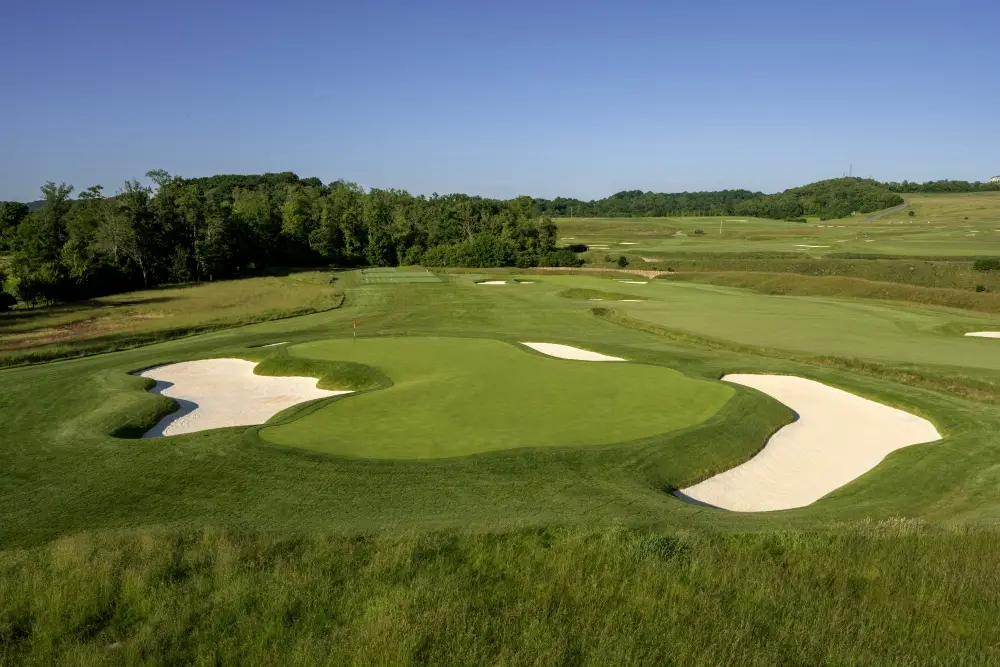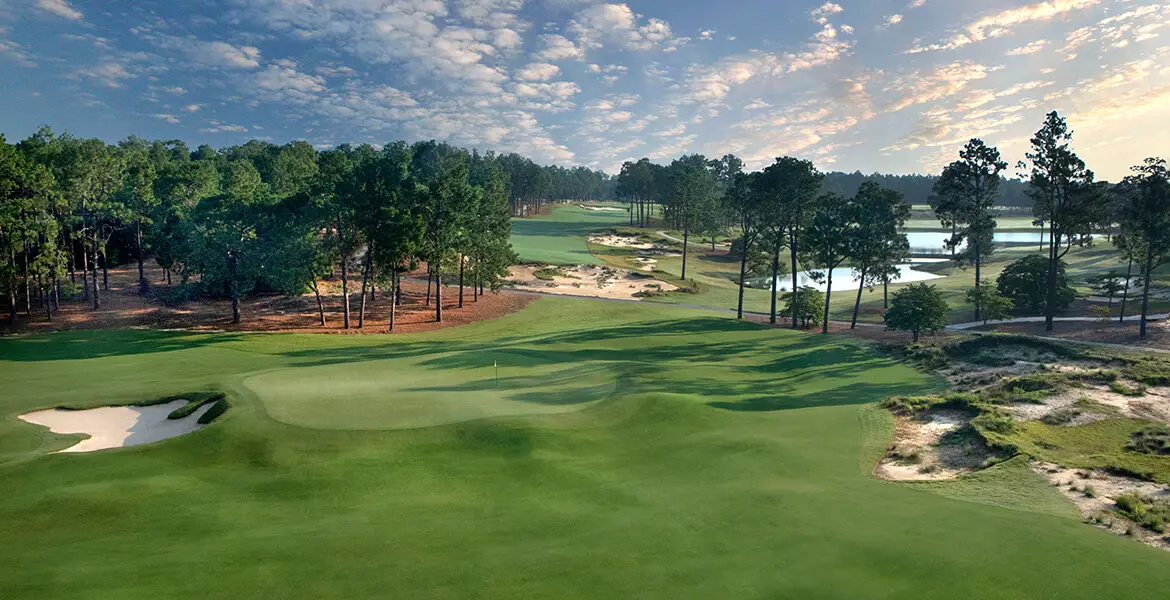A Gil Hanse facelift has restored old wrinkles—and old-style trouble—to Pittsburgh’s famously feared U.S. Open layout
The last time Oakmont took center stage, huge-hitting 2021 U.S. Amateur contestants were having their way with the vaunted and generally feared layout by opting for cross-country routes in their tee-to-green journeys, smashing tee shots into adjacent fairways, and turning daunting approaches into easy ones. The club summoned Gil Hanse in 2022, apparently to short-circuit the missiles and return Oakmont to the pedestal it topped as golf’s toughest test. That scenario made perfect sense; however, that’s not what happened. Hanse indeed transformed Oakmont, but not to make it tougher.
Any connoisseur of golf history and course architecture knows of Oakmont’s fearsome reputation. Steelman Henry Fownes draped Oakmont over moderately rolling farmland 14 miles northeast of Pittsburgh in 1903. He modeled it after the links courses of Great Britain, and it soon attracted attention as the most demanding tournament track in America.
Tommy Armour captured the 1927 U.S. Open here, with 13-over-par 301 making the playoff. Following the steel shaft revolution in the early 1930s, scores were expected to plunge at Oakmont’s next U.S. Open in 1935. They did not. Winner Sam Parks shot 299—and won by two.

Things didn’t get appreciably easier in subsequent tournaments. Gene Sarazen described Oakmont as possessing “all the charm of a sock to the head.” Echoed Johnny Miller, “It’s the most difficult test of golf in America.” And that’s coming from two guys who won majors here 51 years apart. Even in 2016, with par reduced to 70, only one player finished better than one-under for the duration, winner Dustin Johnson. Hard is embedded in the club’s DNA. It’s exactly how the founders wanted it.
“A shot poorly played should be a shot irrevocably lost,” thundered Fownes, who was a nationally prominent scratch golfer. “Let the clumsy, the spineless, the alibi artist stand aside.”
Yet, with all that tough talk about Oakmont’s toughness, Hanse’s mission had nothing to do with players taking unorthodox routes at the ’21 Amateur. Instead, the work intended to focus on improving drainage and irrigation. Once the club embarked on that project, only then did the other tweaks occur, both retro and forward-looking.
“The 2021 U.S. Amateur did not prompt the [Hanse] project,” says Devin Gee, a 19-year Oakmont staffer, the last nine as head golf professional. “Oakmont decided to proceed with the historical restoration for several reasons. First was the replacement of a 20-plus-year-old irrigation system. Second, the bunkers were over 18 years old and it was time to replace drainage and reconstruct many of them. Third, in order to reconstruct the greenside bunkers, recovering and expanding green edges was required. Fourth, length was added to the golf course, but we also added many forward tees for our members. The 2021 U.S. Amateur was not a factor in any of these decisions.”
Admittedly, all elite clubs upgrade infrastructure—irrigation and drainage—when it’s time. Not every top-10 course, however, makes over its tees, greens, and bunkers with each cycle. When a club of Oakmont’s stature takes that route, it’s news. Gil Hanse shared with LINKS what he, partner Jim Wagner, and their team at Hanse Golf Course Design accomplished at Oakmont—and why they did so.

“We did something very different at Oakmont,” says Hanse. “We researched the course from 1903 to 1947, the period during which at least one of the Fowneses [Oakmont founder H.C. Fownes and his son W.C., who succeeded him as club president] was involved in the design decisions. During that time, the course underwent changes almost on an annual basis. As a result, it would have been truly difficult to determine what iteration of the entire course was best. So we decided, with the club’s support, to look at each hole on an individual basis and try to determine what iteration of each hole would be the best fit for the way the game is played today. This creates an eclectic 18 holes, with the common denominator being one of the Fowneses was involved in the creation of that version of the hole.”
For all the scare tactics Oakmont conjures up, it is its collection of greens that terrorizes most thoroughly. “They are by far the most difficult greens I’ve ever played,” gasped Tiger Woods at the 2007 U.S. Open. Hanse risked considerable capital in altering perhaps golf’s most iconic set of putting surfaces, but he did just that.
“We referenced a lot of early photos, 1920s and 1930s, to come up with the look and feel of the greens,” says Hanse. “In their original configurations, the greens didn’t change much during the Fowneses’ tenure. They were much more of a table-top nature. Over time they had evolved through sand buildup along the edges, to a place where the putting surface was not the high point of the green complex—the edges were higher than the center. We have reversed that and they now flow directly into the bunkers, rather than the bunkers flowing into the greens.”
By restoring what Hanse calls the “edge conditions” on the greens, balls that are rolling toward the edges will now go off the edges instead of being held up by bunker sand buildup. In all, 24,000 square feet of green expansions were installed across all 18 holes. The heftiest put-back was 2,500 square feet at the par-four 3rd, but green surface additions to holes 2, 7, 13, 16, and 18 also stand out for their enlargements. Hanse predicted that many of these greens will likely feature new hole locations not seen in a long time. On the 182-yard par-three 13th, for instance, there were previously just two left-side cuppable areas; now there are six, including a ripsnorter, back-right in a bowl.

Some Oakmont old-timers wondered if changing the high points of the greens will actually make them easier, a dreaded word around these parts. Modifying the greens to make them more like Pinehurst No. 2—high point in the middle—means that missing a green will leave a presumably simpler uphill chip. Those same low-handicap members also question whether the flattening of fairway bunker bottoms detracts from their difficulty. Hanse rebuts that notion, stating that unpredictability from your lie in the sand was inherent from the start.
“The bunkers at Oakmont were always intended to deal a heavy penalty to those who entered them—think furrowed sand, and deep,” says Hanse. “We looked closely at the depth part of the original bunkers, and they were not as deep as the evolved bunkers that had been in place since the early 2000s. So, we made them slightly shallower and altered their top lines to feel more like those that the Fowneses had constructed. We used a technique at the base of the bunkers—they are primarily grass-faced—where we created a vertical face at the toe of the slope. If your ball rolls up against this face, you will be wedging out of them. If your ball stays away from the face you will be able to get more club on the ball than you would have several years ago. We feel that this vertical face has retained the difficulty quotient intended by the founders while also restoring some of the rub of the green character found in the old furrowed bunkers.”
As a result, if a right-handed U.S. Open competitor’s shot races into a fairway bunker, he may have to pitch out sideways, or even left-handed, if he’s up against the bunker wall. If his shot merely trickles into the front portion of the bunker, he may well be able to escape the sand with a hybrid.
Mostly, 2025 Oakmont will look like its 2021 and 2016 versions. On several holes, however, the differences are flashing in neon. Not only were nearly 40 yards added to the par-four 3rd hole, stretching it to 462 yards, but Hanse changed the most infamous bunker complex on the course, the “Church Pews” that adorn the left side of holes 3 and 4, by adding two rows of pews. The Church Pews now stretch 100 yards in length and are 40 yards wide.
“We wanted to make sure the Pews were still in position to challenge the landing area of the longest players,” explains Hanse. “The Pews were also rebuilt to be less consistent from pew to pew, much like the ones originally constructed by the Fowneses.”

Another important alteration occurred at the 485-yard par-four 7th. Hanse installed a cross bunker on the left and significantly expanded the fairway on the right. “The tee shot on hole 7 plays differently, both aesthetically and strategically,” says Gee. “There is now an option to play to the right, short of the fairway bunkers [and face a potentially blind approach], or the player can play to the left side of the fairway, taking on more risk with bunkers [figure a 320-yard carry], but the angle of the green is more favorable.”
The 400-yard par-four 11th was lengthened by 21 yards from 2016, with the new back tee set on the other side of a maintenance road and moved farther right, which brings into play Hanse’s other major change. “We did some earth work to the right side of the hole, which allowed us to restore the fairway all the way to the ditch that flanks the right side of the hole,” he says. With short grass instead of rough in place, look for that ubiquitous ditch to claim many more victims in 2025.
And, intentionally or not, Hanse and the club have made adjustments to halt the cross-country excursions, notably revising and expanding the bunker complex between the 461-yard par-four 10th and number 11 and resurrecting the ditch that crosses the 10th fairway at a 45-degree angle.
Despite the added fairway width and shallower bunkers, expect the usual ferocity from Oakmont. “It was made clear to us that the membership did not want the course to play easier,” says Hanse. “Oakmont has always been unapologetically difficult. Through a combination of green expansions, bunker locations, and fairway shifting we feel like we have retained the difficulty for the skilled player but made it more friendly for the average golfer.”
If the course stays dry this June, Oakmont will be the vicious U.S. Open test the Fowneses envisioned. It may not be a sock to the head, but expect post-round aspirin to be a hot commodity.







That is a huge difference! Goodjob!
Nice changes. Hanse is a pro! Love Oakmont. Played there as a guest for several years….greatest (and, toughest) greens on the planet…understated class, dripping with history in the clubhouse…most “caddie dependent” rounds I’ve played worldwide! Kudos to the loopers there! Can’t wait to see the pros in action at the Open this week!